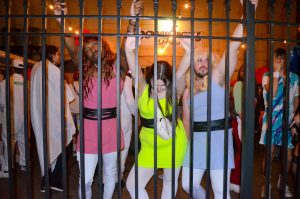Guest Column: Social media: It’s so 1st century BC
November 2, 2013
Today, it’s easy to assume social media platforms are a recent development, a phenomenon unique to the Internet age. But the exchange of media along social networks of friends and acquaintances is in fact much older than Facebook, Twitter or MySpace.
Consider the situation in the late Roman republic, in the 1st century BC. At the time there were no printing presses and no paper. Instead, information circulated among the intermarried families of the Roman elite through the exchange of papyrus rolls. The correspondence of the Roman statesman Marcus Tullius Cicero, the best preserved collection of letters from the period, shows that he and his friends wrote to one another constantly, recounting the latest political machinations, passing on items of interest from others and providing commentary and opinion.
“I sent you on March 24th a copy of Balbus’ letter to me and of Caesar’s letter to him,” Cicero wrote to a friend in one typical example. Letters were commonly copied, shared and quoted in other letters. Some missives were addressed to several people and were intended to be read aloud or posted in public. When Cicero or another politician made a noteworthy speech, he would distribute it by making copies available to his associates, who would read it and pass it on to others. Many more people might then read the speech than had heard it being delivered in person.
Books circulated in a similar way, as sets of papyrus rolls passed from one reader to the next. Anyone who wished to retain a copy of a speech or book would have it copied by scribes before passing it on. People in Rome also sent their friends excerpts from the state gazette, a bulletin posted in the Forum each day containing official announcements and summaries of political debates.
With information flitting from one person to another, this informal system enabled information to reach the farthest corners of the Roman world within a few weeks. News from Rome took about five weeks to reach Britain in the west and seven weeks to reach Syria in the east. Merchants, soldiers and officials in distant parts would circulate information from the heart of the republic within their own social circles back to their contacts in Rome.
This was a world in which people gathered, filtered and distributed information for their friends. It was, in short, a social media system.
For most of history, in fact, media was social. The emergence of centralized mass media such as newspapers, radio and television is a very recent phenomenon, and is arguably a historical anomaly. Today, we like to draw a distinction between “new” media based on digital technologies and the “old” media that came before it. But the centralized, impersonal distribution systems of old media only emerged in the mid-1800s, and the situation before then — what could be termed the era of “really old media” — has many similarities with today’s media environment. In many respects, the emergence of Internet-based social media in recent years is therefore a return to the way things used to be.
These similarities can be instructive because it turns out that ancient forms of social media prompted many of the same questions that Facebook, Twitter, Tumblr and the rest have raised today. Do new forms of social media lead to a trivialization and coarsening of public discourse, for example? How should those in authority respond when they face criticism in social media? To what extent can social media help bring about political change? Is it all just a distracting waste of time?
Examining the impact of social media systems that arose in centuries past can help us answer these questions and put today’s worries in perspective. At the same time, our modern experience of social media enables us to see the past with new eyes. The deepest lesson is that when you send a tweet or share a link on Facebook, you are continuing a deep and rich tradition of person-to-person sharing that goes back to Roman times, more than 2,000 years ago. Social media does not simply link us to each other today — it also links us to the past
Tom Standage is digital editor of the Economist and the author of the newly published “Writing on the Wall: Social Media — The First 2,000 years.” He wrote this for the Los Angeles Times.








